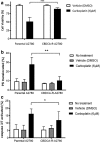Functional and transcriptomic characterization of carboplatin-resistant A2780 ovarian cancer cell line
- PMID: 30894224
- PMCID: PMC6427839
- DOI: 10.1186/s40659-019-0220-0
Functional and transcriptomic characterization of carboplatin-resistant A2780 ovarian cancer cell line
Abstract
Background: Ovarian cancer is a significant cancer-related cause of death in women worldwide. The most used chemotherapeutic regimen is based on carboplatin (CBDCA). However, CBDCA resistance is the main obstacle to a better prognosis. An in vitro drug-resistant cell model would help in the understanding of molecular mechanisms underlying this drug-resistance phenomenon. The aim of this study was to characterize cellular and molecular changes of induced CBDCA-resistant ovarian cancer cell line A2780.
Methods: The cell selection strategy used in this study was a dose-per-pulse method using a concentration of 100 μM for 2 h. Once 20 cycles of exposure to the drug were completed, the cell cultures showed a resistant phenotype. Then, the ovarian cancer cell line A2780 was grown with 100 μM of CBDCA (CBDCA-resistant cells) or without CBDCA (parental cells). After, a drug sensitivity assay, morphological analyses, cell death assays and a RNA-seq analysis were performed in CBDCA-resistant A2780 cells.
Results: Microscopy on both parental and CBDCA-resistant A2780 cells showed similar characteristics in morphology and F-actin distribution within cells. In cell-death assays, parental A2780 cells showed a significant increase in phosphatidylserine translocation and caspase-3/7 cleavage compared to CBDCA-resistant A2780 cells (P < 0.05 and P < 0.005, respectively). Cell viability in parental A2780 cells was significantly decreased compared to CBDCA-resistant A2780 cells (P < 0.0005). The RNA-seq analysis showed 156 differentially expressed genes (DEGs) associated mainly to molecular functions.
Conclusion: CBDCA-resistant A2780 ovarian cancer cells is a reliable model of CBDCA resistance that shows several DEGs involved in molecular functions such as transmembrane activity, protein binding to cell surface receptor and catalytic activity. Also, we found that the Wnt/β-catenin and integrin signaling pathway are the main metabolic pathway dysregulated in CBDCA-resistant A2780 cells.
Keywords: A2780 cell line; Carboplatin; Drug resistance; Integrin signaling pathway; Ovarian cancer; Wnt/β-catenin-signaling pathway.
Conflict of interest statement
The authors declare that they have no competing interests.
Figures







Similar articles
-
SREBP2 contributes to cisplatin resistance in ovarian cancer cells.Exp Biol Med (Maywood). 2018 Apr;243(7):655-662. doi: 10.1177/1535370218760283. Epub 2018 Feb 22. Exp Biol Med (Maywood). 2018. PMID: 29466876 Free PMC article.
-
Interference with the expression of β-catenin reverses cisplatin resistance in A2780/DDP cells and inhibits the progression of ovarian cancer in mouse model.DNA Cell Biol. 2015 Jan;34(1):55-62. doi: 10.1089/dna.2014.2626. DNA Cell Biol. 2015. PMID: 25211326
-
Elevated β-catenin activity contributes to carboplatin resistance in A2780cp ovarian cancer cells.Biochem Biophys Res Commun. 2015 Dec 4-11;468(1-2):173-8. doi: 10.1016/j.bbrc.2015.10.138. Epub 2015 Oct 29. Biochem Biophys Res Commun. 2015. PMID: 26522223
-
The impact of non-genetic heterogeneity on cancer cell death.Crit Rev Biochem Mol Biol. 2018 Feb;53(1):99-114. doi: 10.1080/10409238.2017.1412395. Epub 2017 Dec 18. Crit Rev Biochem Mol Biol. 2018. PMID: 29250983 Free PMC article. Review.
-
Basic research: how much do we know, and what are we likely to learn about ovarian cancer in the near future?Ann Oncol. 1999;10 Suppl 1:69-73. doi: 10.1023/a:1008367620240. Ann Oncol. 1999. PMID: 10219457 Review.
Cited by
-
Harnessing preclinical models for the interrogation of ovarian cancer.J Exp Clin Cancer Res. 2022 Sep 16;41(1):277. doi: 10.1186/s13046-022-02486-z. J Exp Clin Cancer Res. 2022. PMID: 36114548 Free PMC article. Review.
-
Reduced expression of enolase-1 correlates with high intracellular glucose levels and increased senescence in cisplatin-resistant ovarian cancer cells.Am J Transl Res. 2020 Apr 15;12(4):1275-1292. eCollection 2020. Am J Transl Res. 2020. PMID: 32355541 Free PMC article.
-
Identification and Comprehensive Analysis of circRNA-miRNA-mRNA Regulatory Networks in A2780 Cells Treated with Resveratrol.Genes (Basel). 2024 Jul 22;15(7):965. doi: 10.3390/genes15070965. Genes (Basel). 2024. PMID: 39062744 Free PMC article.
-
DNA Double-Strand Break Repair Inhibitors: YU238259, A12B4C3 and DDRI-18 Overcome the Cisplatin Resistance in Human Ovarian Cancer Cells, but Not under Hypoxia Conditions.Curr Issues Mol Biol. 2023 Sep 28;45(10):7915-7932. doi: 10.3390/cimb45100500. Curr Issues Mol Biol. 2023. PMID: 37886943 Free PMC article.
-
Conjugates Containing Two and Three Trithiolato-Bridged Dinuclear Ruthenium(II)-Arene Units as In Vitro Antiparasitic and Anticancer Agents.Pharmaceuticals (Basel). 2020 Dec 16;13(12):471. doi: 10.3390/ph13120471. Pharmaceuticals (Basel). 2020. PMID: 33339451 Free PMC article.
References
-
- Alberts DS. Carboplatin versus cisplatin in ovarian cancer. Semin Oncol. 1995;22:88–90. - PubMed
MeSH terms
Substances
Grants and funding
- 21140129/Comisión Nacional de Investigación Científica y Tecnológica
- 21151406/Comisión Nacional de Investigación Científica y Tecnológica
- 11150802/Fondo Nacional de Desarrollo Científico y Tecnológico
- 11150622/Fondo Nacional de Desarrollo Científico y Tecnológico
- 3180550/Fondo Nacional de Desarrollo Científico y Tecnológico
LinkOut - more resources
Full Text Sources
Medical
Research Materials

